Abstract
Interferon induction by MM virus in mice and in L cells was studied. In mice the virus readily induced interferon. The time of appearance was dose-dependent. A large virus dose induced interferon by 4 hr, whereas a small dose resulted in interferon production which paralleled virus replication 24 hr after infection. In L cells the interferon-inducing capacity of the virus was rapidly destroyed by ultraviolet light irradiation. Heating (56 C) of the virus, on the other hand, greatly increased its ability to induce interferon. Interferon production could also be increased by prior treatment of the cells with homologous interferon (priming). The increase in interferon production after priming was dependent on the concentration of interferon used for priming, the length of interferon treatment, and the multiplicity of infection. It is suggested that MM virus might be useful for the further study of the mechanisms involved in the production and action of interferon.
Full text
PDF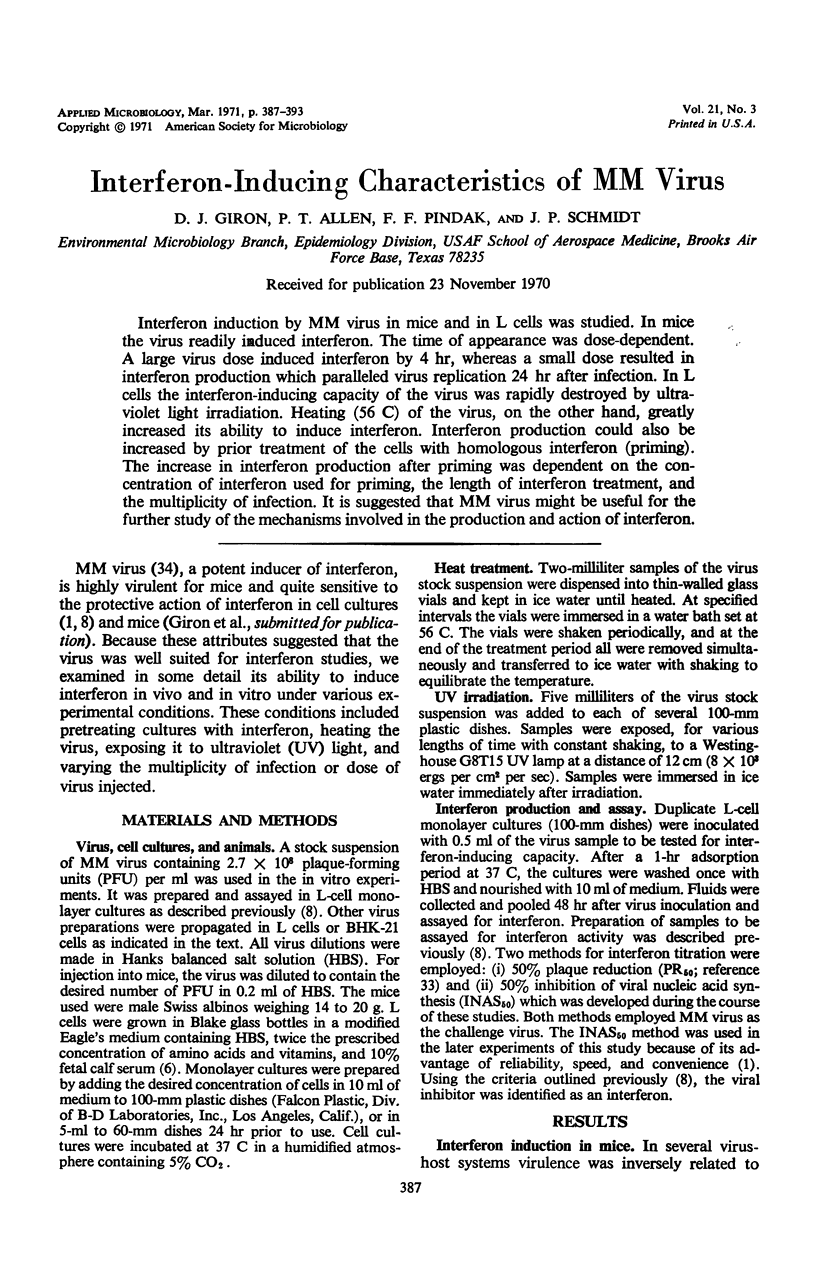
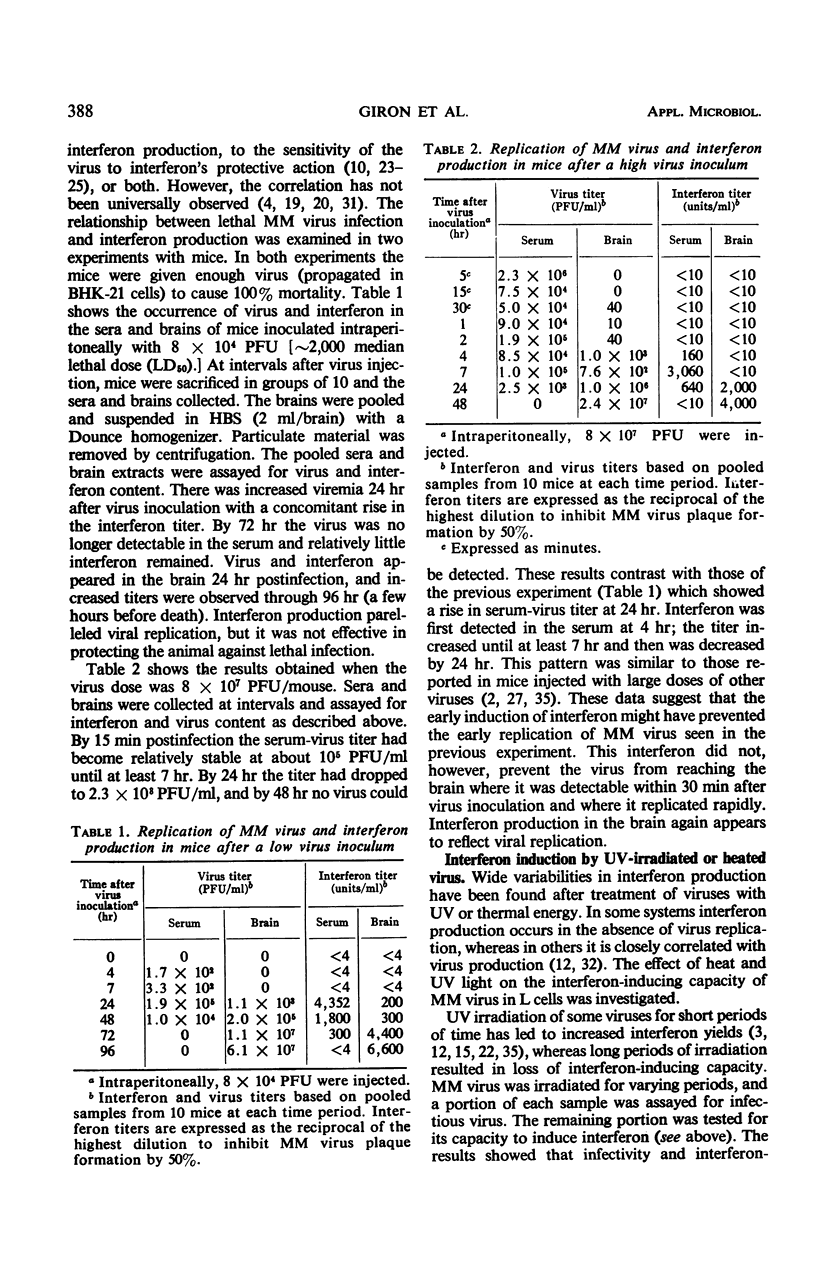
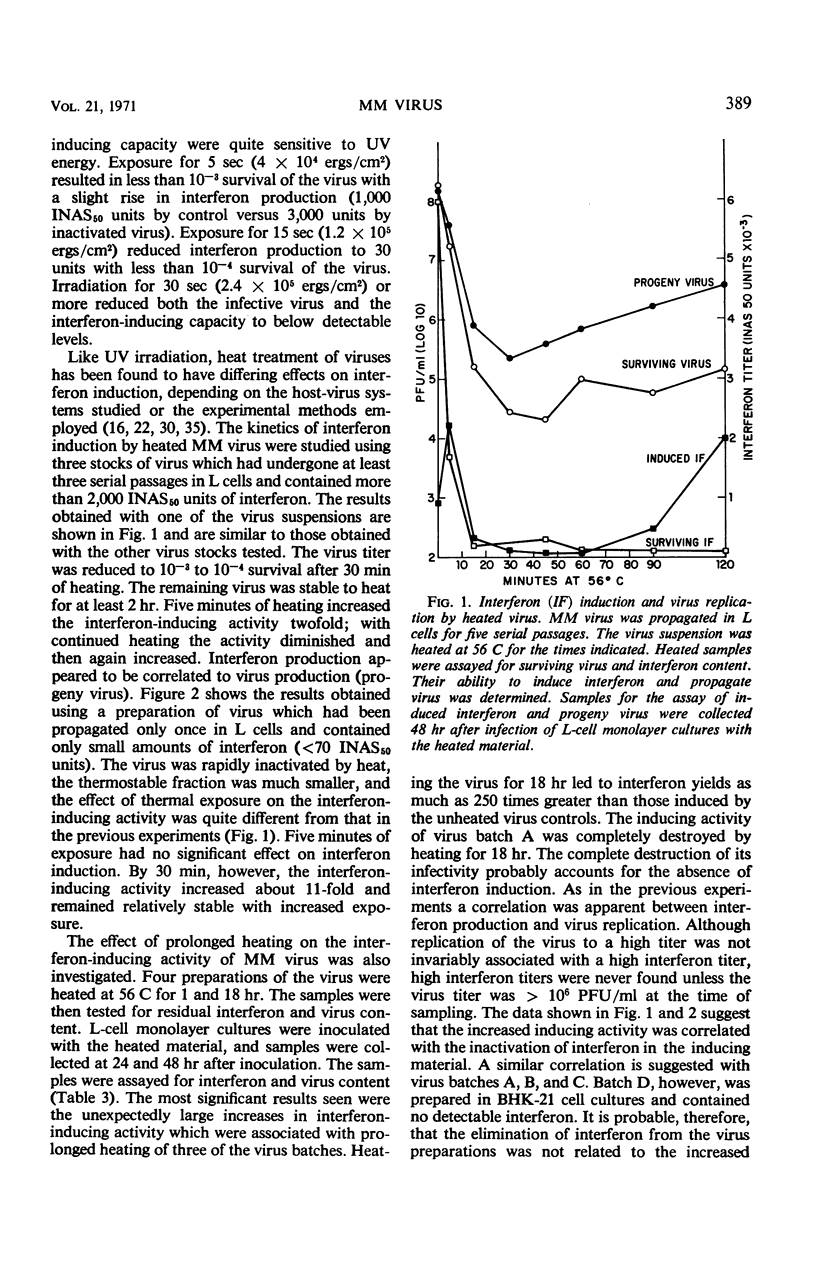

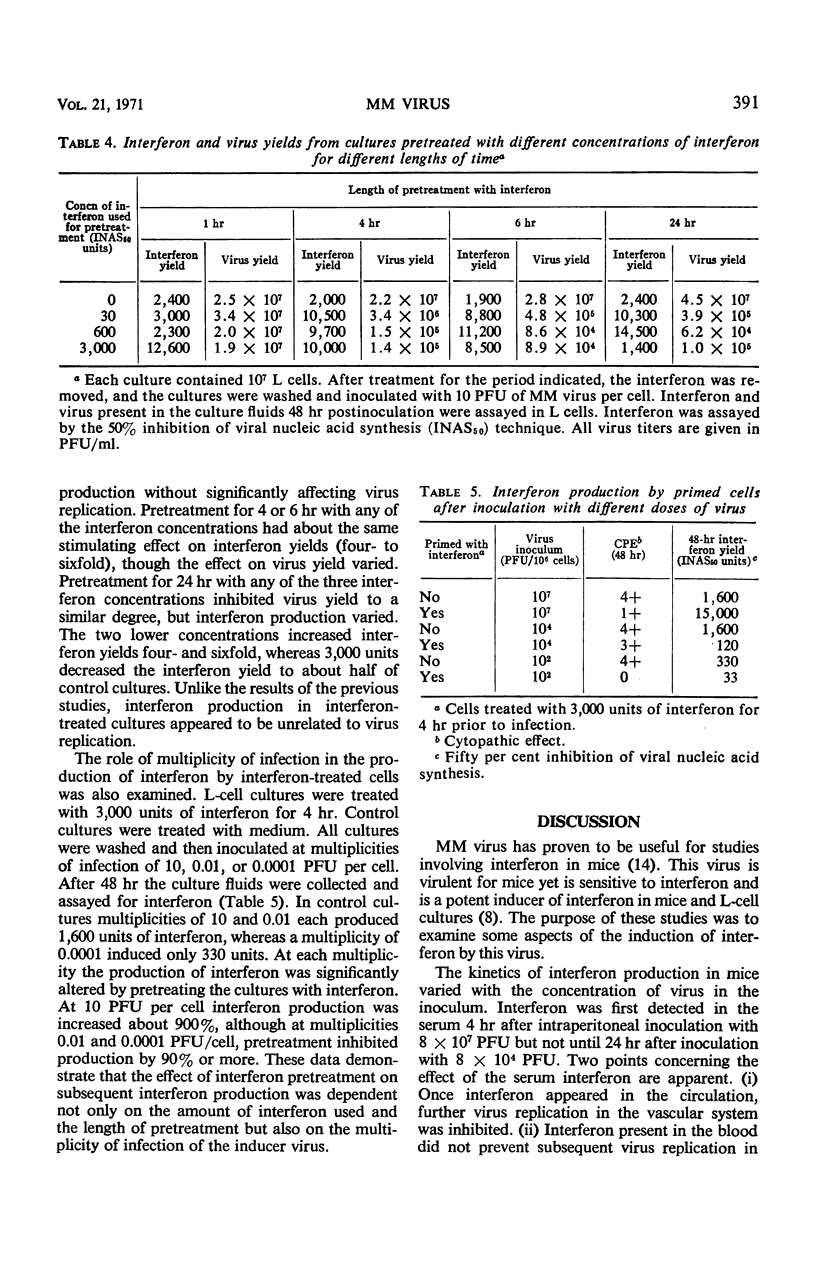
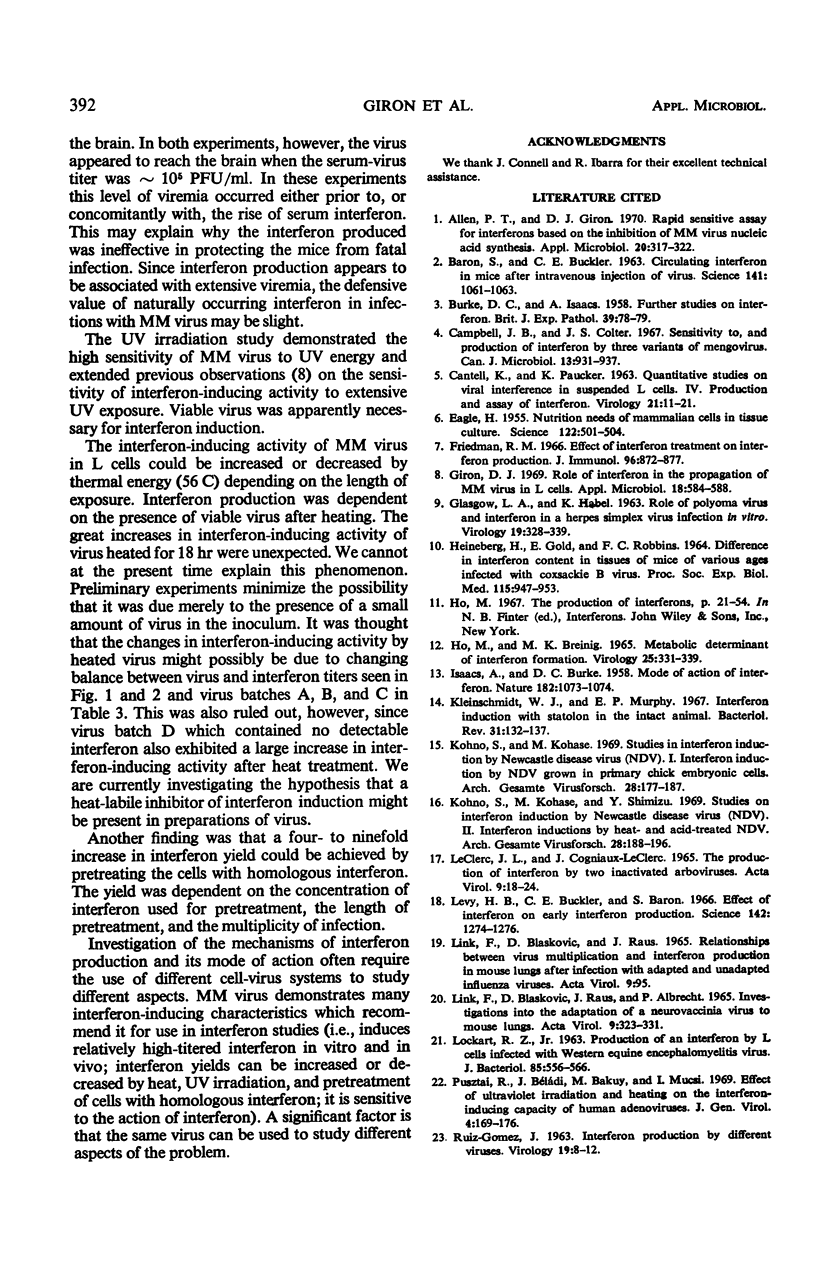
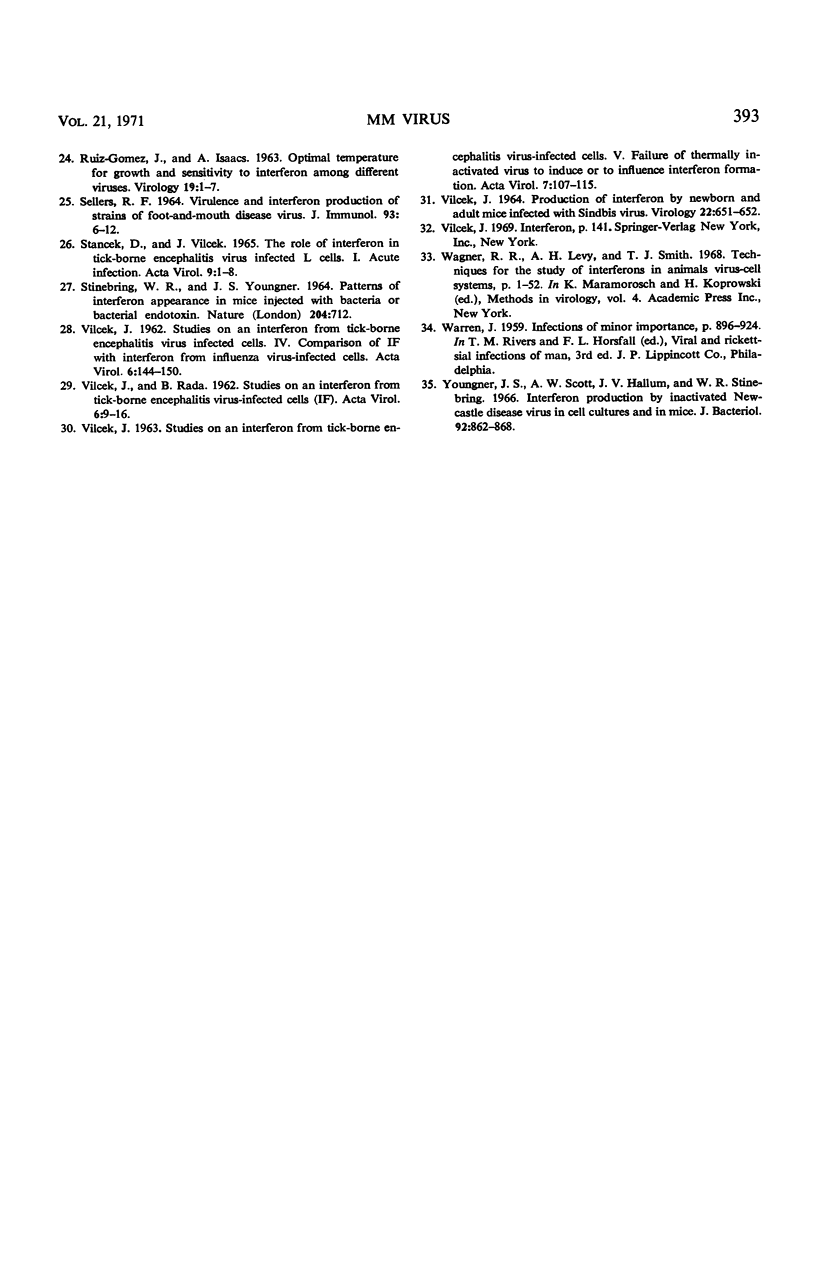
Selected References
These references are in PubMed. This may not be the complete list of references from this article.
- Allen P. T., Giron D. J. Rapid sensitive assay for interferons based on the inhibition of MM virus nucleic acid synthesis. Appl Microbiol. 1970 Sep;20(3):317–322. doi: 10.1128/am.20.3.317-322.1970. [DOI] [PMC free article] [PubMed] [Google Scholar]
- BARON S., BUCKLER C. E. CIRCULATING INTERFERON IN MICE AFTER INTRAVENOUS INJECTION OF VIRUS. Science. 1963 Sep 13;141(3585):1061–1063. doi: 10.1126/science.141.3585.1061. [DOI] [PubMed] [Google Scholar]
- BURKE D. C., ISAACS A. Further studies on interferon. Br J Exp Pathol. 1958 Feb;39(1):78–84. [PMC free article] [PubMed] [Google Scholar]
- CANTELL K., PAUCKER K. QUANTITATIVE STUDIES ON VIRAL INTERFERENCE IN SUSPENDED L CELLS. IV. PRODUCTION AND ASSAY OF INTERFERON. Virology. 1963 Sep;21:11–21. doi: 10.1016/0042-6822(63)90298-8. [DOI] [PubMed] [Google Scholar]
- Campbell J. B., Colter J. S. Sensitivity to, and production of interferon by three variants of Mengo virus. Can J Microbiol. 1967 Aug;13(8):931–937. doi: 10.1139/m67-125. [DOI] [PubMed] [Google Scholar]
- EAGLE H. Nutrition needs of mammalian cells in tissue culture. Science. 1955 Sep 16;122(3168):501–514. doi: 10.1126/science.122.3168.501. [DOI] [PubMed] [Google Scholar]
- Friedman R. M. Effect of interferon treatment on interferon production. J Immunol. 1966 May;96(5):872–877. [PubMed] [Google Scholar]
- GLASGOW L. A., HABEL K. Role of polyoma virus and interferon in a herpes simplex virus infection in vitro. Virology. 1963 Mar;19:328–339. doi: 10.1016/0042-6822(63)90072-2. [DOI] [PubMed] [Google Scholar]
- Giron D. J. Role of interferon in the propagation of MM virus in L cells. Appl Microbiol. 1969 Oct;18(4):584–588. doi: 10.1128/am.18.4.584-588.1969. [DOI] [PMC free article] [PubMed] [Google Scholar]
- HEINEBERG H., GOLD E., ROBBINS F. C. DIFFERENCES IN INTERFERON CONTENT IN TISSUES OF MICE OF VARIOUS AGES INFECTED WITH COXSACKIE B1 VIRUS. Proc Soc Exp Biol Med. 1964 Apr;115:947–953. doi: 10.3181/00379727-115-29086. [DOI] [PubMed] [Google Scholar]
- HO M., BREINIG M. K. METABOLIC DETERMINANTS OF INTERFERON FORMATION. Virology. 1965 Mar;25:331–339. doi: 10.1016/0042-6822(65)90052-8. [DOI] [PubMed] [Google Scholar]
- ISAACS A., BURKE D. C. Mode of action of interferon. Nature. 1958 Oct 18;182(4642):1073–1074. doi: 10.1038/1821073a0. [DOI] [PubMed] [Google Scholar]
- Kleinschmidt W. J., Murphy E. B. Interferon induction with statolon in the intact animal. Bacteriol Rev. 1967 Jun;31(2):132–137. doi: 10.1128/br.31.2.132-137.1967. [DOI] [PMC free article] [PubMed] [Google Scholar]
- Kohno S., Kohase M., Shimizu Y. Studies on interferon induction by Newcastle disease virus (NDV). II. Interferon inductions by heat- and acid-treated NDV. Arch Gesamte Virusforsch. 1969;28(2):188–196. doi: 10.1007/BF01249383. [DOI] [PubMed] [Google Scholar]
- Kohno S., Kohase M. Studies on interferon induction by Newcastle disease virus (NDV). I. Interferon indiction by NDV grown in primary chick embryonic cells. Arch Gesamte Virusforsch. 1969;28(2):177–187. doi: 10.1007/BF01249382. [DOI] [PubMed] [Google Scholar]
- LECLERC J. L., COGNIAUX-LECLERC J. THE PRODUCTION OF INTERFERON BY TWO INACTIVATED ARBOVIRUSES. Acta Virol. 1965 Jan;9:18–24. [PubMed] [Google Scholar]
- LINK F., BLASKOVIC D., RAUS J. RELATIONSHIP BETWEEN VIRUS MULTIPLICATION AND INTERFERON PRODUCTION IN MOUSE LUNGS AFTER INFECTION WITH ADAPTED AND UNADAPTED INFLUENZA VIRUSES. Acta Virol. 1965 Jan;9:95–95. [PubMed] [Google Scholar]
- LOCKART R. Z., Jr PRODUCTION OF AN INTERFERON BY L CELLS INFECTED WITH WESTERN EQUINE ENCEPHALOMYELITIS VIRUS. J Bacteriol. 1963 Mar;85:556–566. doi: 10.1128/jb.85.3.556-566.1963. [DOI] [PMC free article] [PubMed] [Google Scholar]
- Levy H. B., Buckler C. E., Baron S. Effect of interferon on early interferon production. Science. 1966 May 27;152(3726):1274–1276. doi: 10.1126/science.152.3726.1274. [DOI] [PubMed] [Google Scholar]
- Pusztai R., Béládi I., Bakay M., Mucsi I. Effect of ultraviolet irradiation and heating on the interferon-inducing capacity of human adenoviruses. J Gen Virol. 1969 Mar;4(2):169–176. doi: 10.1099/0022-1317-4-2-169. [DOI] [PubMed] [Google Scholar]
- RUIZ-GOMEZ J., ISAACS A. Interferon production by different viruses. Virology. 1963 Jan;19:8–12. doi: 10.1016/0042-6822(63)90018-7. [DOI] [PubMed] [Google Scholar]
- RUIZ-GOMEZ J., ISAACS A. Optimal temperature for growth and sensitivity to interferon among different viruses. Virology. 1963 Jan;19:1–7. doi: 10.1016/0042-6822(63)90017-5. [DOI] [PubMed] [Google Scholar]
- SELLERS R. F. VIRULENCE AND INTERFERON PRODUCTION OF STRAINS OF FOOT-AND MOUTH DISEASE VIRUS. J Immunol. 1964 Jul;93:6–12. [PubMed] [Google Scholar]
- STANCEK D., VILCEK J. THE ROLE OF INTERFERON IN TICK-BORNE ENCEPHALITIS VIRUS-INFECTED L CELLS. I. ACUTE INFECTION. Acta Virol. 1965 Jan;9:1–8. [PubMed] [Google Scholar]
- STINEBRING W. R., YOUNGNER J. S. PATTERNS OF INTERFERON APPEARANCE IN MICE INFECTED WITH BACTERIA OR BACTERIAL ENDOTOXIN. Nature. 1964 Nov 14;204:712–712. doi: 10.1038/204712a0. [DOI] [PubMed] [Google Scholar]
- VILCEK J. PRODUCTION OF INTERFERON BY NEWBORN AND ADULT MICE INFECTED WITH SINDBIS VIRUS. Virology. 1964 Apr;22:651–652. doi: 10.1016/0042-6822(64)90091-1. [DOI] [PubMed] [Google Scholar]
- VILCEK J., RADA B. Studies on an interferon from tickborne encephalitis virus-infected cells (IF). III. Antiviral action of IF. Acta Virol. 1962 Jan;6:9–16. [PubMed] [Google Scholar]
- VILCEK J. Studies on an interferon from tick-borne encephalitis virus-infected cells (IF). IV. Comparison of IF with interferon from influenza virus-infected cells. Acta Virol. 1962 Mar;6:144–150. [PubMed] [Google Scholar]
- Youngner J. S., Scott A. W., Hallum J. V., Stinebring W. R. Interferon production by inactivated Newcastle disease virus in cell cultures and in mice. J Bacteriol. 1966 Oct;92(4):862–868. doi: 10.1128/jb.92.4.862-868.1966. [DOI] [PMC free article] [PubMed] [Google Scholar]


